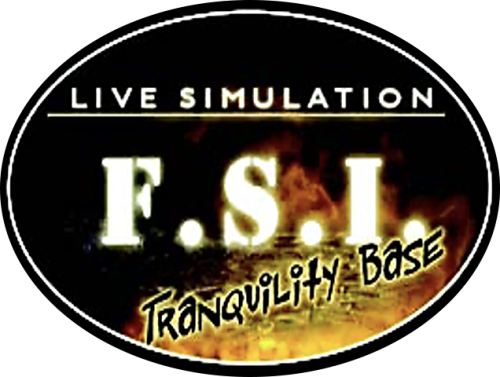F.S.I. (Fire Scene Investigation)
For Teachers
FSI Introduction
Welcome to the FSI live simulation web site. Here, you will find everything you need to run this simulation effectively in your classroom.
What is the FSI live simulation?
Fire Scene Investigation: Tranquility Base (FSI) is a live “mission” conducted in your classroom through videoconferencing. It features teams of students using real-time data to complete the mission directive. The accompanying website provides five to ten class periods of mission preparation materials including the standards addressed, scope and sequence, lesson plans, and student materials.
Is this only for classes?
FSI was created to reinforce certain math concepts for grades 5-8:
-
Calculating the area and volume of an odd-shaped room
-
Determining measures of central tendency (mean, median, mode)
-
Creating and interpreting box-and-whiskers plots
The program is an innovative way to engage students by integrating both math topics and authentic space science in a real-time context. The website includes resources for integrating science topics.
How is the program used?
| Schedule date → | Brief the students → | Math lessons → | Pre-Mission Prep → | Conduct the mission |
-
Schedule a mission date with the Challenger Learning Center.
-
“Brief” the students on the mission.
-
Use lesson plans provided on the website to reinforce the relevant math concepts.
-
Conduct optional careers and family involvement activities.
-
-
Prepare students for the mission by completing a “mini-mission” to apply math concepts.
-
Split students into teams, set up the classroom with data computers.
-
Conduct test videoconference link with the Challenger Learning Center.
-
-
Link with the Challenger Learning Center; conduct mission!
In what way is the simulation conducted in "real-time"?
The mission is a student-centered, team-based, interactive educational experience that makes use of scientifically accurate data to solve problems. Teachers run the simulations in their own classrooms through the Internet using video conferencing equipment or they use nearby distance learning labs. The classroom is connected with a Mission Director who guides the problem-solving activities to a successful conclusion.
In the FSI simulation, students work as Fire Scene Investigators, Oxygen and Carbon Dioxide Specialists, and Communications Specialists in teams of eight. Each team is using fire scene data collected by sensors in a lunar base to determine the cause. Investigators calculate the volume of the room, and use a graph to track oxygen percent & heat release over time. Oxygen and Carbon Dioxide Specialists use an online tool to change certain variables and match results against the actual data. Communications Specialists coordinate all these activities with the Mission Director and examine all the evidence to determine the cause of the fire.
Is this just for fun or do students really learn?
The program was designed by middle and high school teachers, educational researchers, and subject matter experts. FSI joins the lineup of innovative distance learning programs offered by the Challenger Learning Center and the Center for Educational Technologies. Simulations are an interactive way for you to effectively use technology in your classroom. Research indicates that this way of learning leads to improved problem-solving and critical-thinking skills and teaches students the importance of teamwork and communication.
Shifting to digital learning is critical to the success of education in America. FSI creates an opportunity for you to apply various technologies and provides necessary digital content lacking in so many computer classrooms.
Good luck on your mission!
The Center for Educational Technologies® at WJU has developed a series of innovative programs for digital learning. These programs provide teachers with an all-inclusive package comprised of curriculum aligned with state and national standards and a live “mission” via technology. The programs were designed around best practice models and principles derived from the latest educational research.

